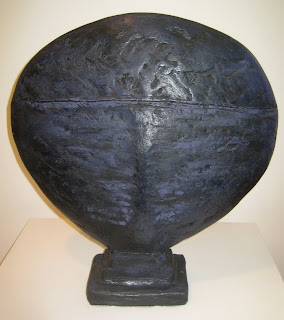Usually when you are seeking those fabulous Australian works from the 50s, 60s and 70s, you generally start at the secondary market and seek out the reputable auction houses or dealers who’ve been around forever. Peter Pinson Gallery in Woollahra is a relatively new commercial gallery which specialises in this era and which mostly represents living artists, who are alive and well and still at it well into this century. www.peterpinsongallery.com It’s in a great neck of the woods – same strip on Edgecliff Rd as Sambag www.sambag.com.au, No Chintz www.nochintz.com, Little Joe www.littlejoeny.com and Ecletticca www.eclettica.com.au
Ceramicist Milton Moon AM and some ardent admirers and friends are still well and truly working and the exhibition currently on at Peter Pinson Gallery is a testament to the strength and endurance of their creative output.
Milton Moon. And Friends. And 50 works is a group exhibition of ceramics to celebrate Moon’s first solo exhibition in Sydney at the Rudy Komon Gallery in 1962, that is, fifty years ago. Les Blakeborough (b1932), Marea Gazzard AM(b1928), Peter Rushforth AM (b1930) Shiga Shigeo (1928-2011) and Moon (b1926), share the room with painter Guy Warren (b1921) (in collaboration with Mud ceramics) and the next generation, Merran Esson, Anita Taylor, Mitsuo Shoji, Jan Guy, Susie McMeekin and Peter Pinson himself are all represented here by one or two works each.
You do the maths and work out the combined age and average age and be amazed at the rich history here and what is really represented in terms of experience, technical know-how, shared knowledge and personal connections.This is a serious group of artists who collectively were at the forefront of reinvigorating ceramic practices in Australia.
The exhibition does not offer monuments to an extraordinary career (clay is after all a humble material) but small offerings of beautifully crafted objects brought together in recognition of a respected colleague – Milton Moon.
To show at the Rudy Komon Gallery in its heyday was a coup. Rudy Komon was well known for his love of wine and art. He was a very well respected dealer who showed the leaders in abstract and figurative expressionism: Fred Williams, George Baldessin, Jon Molvig, John Brack, Robert Dickerson, Leonard French and Clifton Plugh. All blokes, mostly from Melbourne. He did show one woman, local and fellow expat Judy Cassab. His gallery in Woollahra was open from 1959 until his death in 1982. (Is there a biog on Komon out there? It would make a fabulous read.) There is a terrific portrait of Komon by Fred Williams that was in the equally terrific major Williams exhibition at the National Gallery of Australia recently and Eric Smith won the 1981 Archibald Prize for his portrait of the ebullient character, now in the AGNSW collection.
 |
| Eric Smith Rudy Komon 1981 oil on canvas 180x 166cm Winner 1981 Archibald Prize Collection The Art Gallery of NSW |
It was out of the groove for Komon to show potters; he was very much a painters’ dealer. Moon was living and working in Brisbane so I wonder what brought them together. Perhaps it was his friend Jon Molvig who was living in Brisbane, represented by Komon and who introduced Moon to Ian Fairweather.
Nonetheless the ceramics would have sat well with Komon’s aesthetic and were obviously worthy of the illustrious company in which they sat.
Moon’s ceramic objects have consistently been described as tough, rugged, free form and with an Australian characteristic. Pinson talks about the work as ‘brutal’, as though the pots themselves have suffered through their birthing.
Moon was practising his craft at a time of great renewal in the craft industry; a time when there was a renewed respect for the handmade unique object and when other techniques and approaches (both philosophical and physical) were being discovered and experimented with.
For a potter, Japan was an obvious place to explore, with its unique and long standing traditions of firing and glazing techniques. Moon visited Japan many times and immersed himself in its traditional ceramic practices and religious philosophies. He spent a long there, connecting in ways that informed and enriched his work and he brought these techniques and approach back to Australia. Rushforth is another whose work has been deeply influenced by Japanese ceramic traditions. Shiga Shigeo came to Australia on the invitation of Les Blakeborough to teach and practise at The Sturt Workshop in the Southern Highlands and he stayed. Each of these artists were teachers as well, as many were, and would have shared their knowledge and experience with their students. These influences run wide and deep.
 |
| Milton Moon Bush pattern (vase form) 2011 37.8x13cm Bush pattern (large bowl form) 2011 33.4×17.8cm image Courtesy the artist and Peter Pinson Gallery |
Despite the Japanese traditional influences, Moon was able to make his work his own and Australian: his inspiration coming from the bush around him. His pots and tubs feel like the earth from which they came, roughened, imprecise, impolite. The markings are more like a natural stain and smear rather than a specific painterly script. Edges can be slashed and seemingly unfinished. The refinement lies not in a delicate nature or appearance but in the processes and techniques that it took to achieve the final object.
Moon has been well acknowledged for his work as a practitioner and advocate. Among other major honours he was awarded one of the few Creative Fellowships by the Australia Council. He was also conferred with honorary doctorate from the Uni of SA in 2008.
Moon also shows with Aptos Cruz Gallery www.aptoscruz.com in the Adelaide Hills where he has lived for many years
I love Marea Gazzard’s work as well. There is a small piece here. Well known for her ceramic sculptural work I find her work deeply moving. For me the shapes she nurtures have an aura of calm and peace about them. They are solid and simple, with a strong connection to an earth bound world in which time has slowed. I’ve always found her work particularly beautiful. If ever you find yourself in a meeting with our PM in Canberra in her office, gaze out the window and consider the Gazzard installation in the private courtyard. It’ll put everything back into perspective. Maybe that is what our politicians should do before they start each day. Gazzard is represented by Utopia Gallery in Danks St Sydney. www.utopiaartsydney.com.au
 |
| Marea Gazzard Janus III 2007 43.5 x 15.5 x 10.5cm image courtesy the artist and Utopia Gallery, Sydney |
Other Sydney-based galleries celebrating a younger generation of ceramic artists which you should check out are Planet in Surry Hills www.planetfurniture.com.au and Object Gallery (which evolved from the Crafts Council Gallery) also in Surry Hills www.object.com.au
Craft, art, design – it’s all interlinked – and for me, the common purpose (if one is needed) is about bringing a thoughtful and enduring beauty into our lives.


No Comments Yet